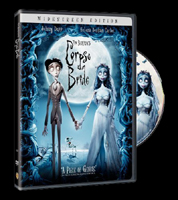 BUY IT AT AMAZON: CLICK HERE!
BUY IT AT AMAZON: CLICK HERE!
STUDIO: Warner Bros.
RATED: PG
MSRP: $28.98
RUNNING TIME: 77 Minutes
SPECIAL FEATURES:
• "Inside the Two Worlds"
• "Danny Elfman Interprets the Two Worlds"
• "The Animators: The Breath of Life"
• "Tim Burton: Dark vs. Light"
• "Voices from the Underworld"
• "Making Puppets Tick"
• "The Voices Behind the Voice"
• Preproduction Galleries
• Music-only track
• Theatrical trailer
(Read
Devin’s theatrical review here, else your soul be damned.)
Imagine a
dark room draped in chrome-plated chains. Imagine the corporate officers of Hot
Topic bowing in obeisance as a mysterious figure clad in dark robes and a
retarded beret enters the room.
"Master
Burton," say the officers. "To what do we owe the honor?"
With a
gracious wave,
been loyal to the cause of spreading Nightmare Before Christmas
merchandise, I have decided to reward you with a diversifying of your stock. I
shall create a new film, one to appeal directly to your core customer base, and
it shall be good."
Tim Burton’s Corpse
Bride is that
film.

"Yes, Old Testament God, I would be glad to receive Thy rod and Thy staff."
The Flick
The story
revolves around three young idealists in (or partially in) a Victorian-era town.
Victor Van Dort, voiced by Johnny Depp, is the son of a fish merchant. His
parents recently came into a good deal of money, thanks to public interest in
fish, but they have no status in society. The best way to attain status in
society? That’s marriage, as Jane Austen would have it. Usually it’s the girl
who marries the guy to climb the social ladder; this reversal immediately sets
up Vincent as a bit of a nancy-boy, the sort of guy who might sing songs about
what color his heart bleeds while wearing girl pants, had he been born to a
different era.
The bride
his parents have selected for him is
well-established Everglot family, who, sadly, have no money whatsoever, but are
in possession of a large mansion and an untapped reserve of pride. The
Everglots aren’t wholly satisfied with young Victor as groom, but they do what
they have to in order to get a hold of some of the van Dort money.
All this
is communicated in the opening musical number, and already there’s an
easy-to-grasp and entertaining conflict; but wait! Poor Victor is shamed by his
nervousness during rehearsals and hightails it to the creepy woods in order to
practice his vows. With an audience of crows, he succeeds in getting them out
in the right order; unfortunately for him, he makes the mistake of saying the
vows to a corpse (Helena Bonham Carter) who, after receiving his wedding ring,
rises up to take Victor down to the underworld, where they can live (and die)
in wedded bliss.
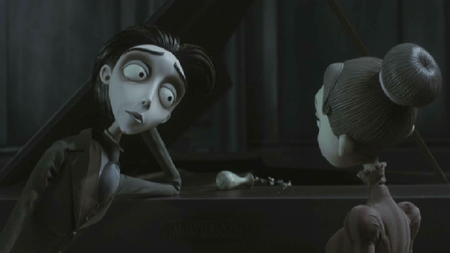
"I call it ‘Still Life Like My Life.’ It’s not much, but I really put my soul into it."
What
follows is a nice spin on the tired old love triangle, in which the two women
are in direct conflict but on generally good terms. Emily, the corpse bride, falls
in love with gentle Victor; Victor is in love with mousey little
be in love with the sound my keyboard makes. At some point, Victor’s affections
sway, and sticks him firmly between the two women. I guess that’s more of a
line segment than a triangle, since Emily and Victoria don’t show any sapphic
tendencies.
It’s a
good setup, and it’s nice to see subtle
changes to familiar dynamics; the only trouble is that for all the setup there
is hardly any payoff. The initial interactions between the three principal
puppets are fun, but it quickly becomes apparent that their characters are
lacking. They aren’t defined by their history or their reactions to the plot,
but each by the one emotion the writers saw fit to hang on their skeletons:
disappointment for
love for Emily.
There’s
not a lot of meat on the individual characters’ bones, but the potential for
good drama between them jumps out at even the least analytical viewer (e.g. my
wife). It’s an indication that the story has got hooks when the audience
doesn’t know who Victor is going to end up with for the first half of the film,
and can’t quite be sure which they would prefer.
Sadly,
the promise of satisfying resolution is swapped out right around the beginning
of the third act in favor of a hurried conclusion (which I imagine had
something to do with the relative difficulty and high expense of creating
footage.) You’ll have to be satisfied with several abrupt character shifts and a
tacked-on bit of metaphysics at the end of your short transportation to
(I would
have preferred more story and less mediocre Danny Elfman musical numbers, but
that’s just me.)
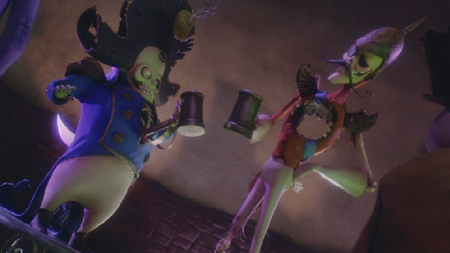
The English and the French united, at last, in misery.
Fans of
stop-motion animation will find plenty to like here. The art-direction and
character design are even more heavily reminiscent of Gorey than they were in Nightmare
Before Christmas, though the imitation isn’t obtrusive. It suits the
mood very well, drawing on the Victorian-styled modern goth aesthetic that
leans impressionable youths toward fake corsets and heavy eye makeup.
The
artistry evident in the art direction and animation go a long way toward
creating a world that feels like a place to spend your time. Depending on your
mood, you might find yourself drawn into the faux-Mexican Land of the Dead (and
relive your memories of Lucasarts’ Grim Fandango) or the dreary,
overcast Land of the Living. Either one is full of tiny details and features a surprisingly
deep focus that emphasizes how much time and effort went into the construction
of the world.
If only
the filmmakers had struck a better balance between story and visuals.
Storywise, Corpse Bride falls down dead. Nightmare Before Christmas
owes some of its continued survival to its story, reminiscent of a fable; it’s
about internal change and expanding borders of awareness. Corpse Bride is, in
comparison, about as deep as a teenager’s diary; the characters are just names
with actions, and I can’t shake the feeling that the whole thing was designed
to appeal to mopey Hot Topic shoppers. It’s a gorgeous and entertaining film,
but the narrative is hampered by divided attention between the technical and story
paths.
7 out of 10
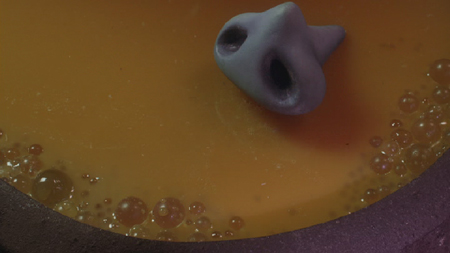
*please listen to "Also Sprach Zarathustra" as you view this cap.
The Look
This film
is drop-dead, hyperbolically beautiful. As evidenced by Wallace and Gromit: Curse of the
Were-Rabbit, these claymation (kind of a misnomer, now; we should call
it silimation) films are displaying levels of artistry higher than ever before.
Corpse
Bride’s Art director Nelson Lowry and production designer Alex
McDowell, along with cinematographer Pete Kozachik, brought a distinct vision
to the screen, and their work is a joy to look at.
The film
comes in both widescreen and full screen versions. The widescreen presentation
has a clear transfer, and for a film that spends an awful lot of time in the
gloom, the darker range of the spectrum comes across as deep and solid. I don’t
suspect the full screen version is any less impressive.
8.5 out of 10
The Noise
I’ve
already mentioned how underwhelming Danny Elfman’s score and original songs
are, but I’ll bring it up again here. If Elfman’s earlier, catchier tunes are
exemplified by Batman, say, then his work for Corpse Bride falls into
the territory marked out by Spider-Man: serviceable, but wholly
forgettable.
The Dolby
5.1 mix also leaves a little something to be desired in the mix, and that
something is clarity. Especially during the musical numbers, the bits of
dialogue that fall in the higher registers end up sounding very muddy. This
gets to be a problem during a couple of the songs which carry the narrative. Emily’s
origin story, for example, is told entirely through a song that borders on
unintelligible.
6.8 out of 10
The Goodies
Hey! It’s
an animated flick with a respectable buttload of bonuses!
There’s
no filmmaker commentary; as compensation, you get seven decent featurettes, a
music-only track, and a theatrical trailer.
"Inside
the Two Worlds" is a set of cast and crew musings on the dichotomy between
the Land of the Dead and the Land of the Living. You get opinions from Tim
Burton, Emily Watson, writer and lyricist John August, and those of a number of
other contributors. It’s a nice range of points-of-view on what was brought to
the production to distinguish the two settings.
"Danny
Elfman Interprets the Two Worlds" is a brief segment on — surprise! —
Elfman’s approach to segmenting off the living and the dead through the score
and musical numbers.
"The
Animators: The Breath of Life" gets into the real meat of the
behind-the-scenes arcana: the tools and methods used to create the stop-motion
animation. The animators speak at length about the improvements to stop-motion
photography that have come about thanks to computerized and digital filmmaking.
Also, a couple of the animators talk about the methods of animating emotion for
the film, which gets covered in a bit more detail in the "Making Puppets
Tick" featurette.
That one
covers the creation of the puppets, and the incorporation of mechanical
elements that were added to the skeletons in order to automate some of the
movements. Also fascinating is the choice to use mechanized faces, rather than
the standard stop-motion method of using different heads for any given
character, with each one featuring a different emotion. The way the Corpse
Bride animators tackled the problem of displaying emotions in their
puppets is a lot more detailed, and results in a far more complicated animation
process.
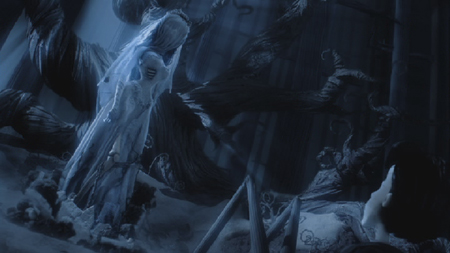
"C’mere, slave. I’ve got some patella needs licking."
We’ve got
a featurette on the director, with "Tim Burton: Dark vs. Light,"
which is a couple brief minutes of various cast and crewmembers praising Tim
Burton, specifically his ability to create a love story in a gothic atmosphere.
"Voices
from the Underworld" checks in with the stars and their experiences as
voice actors, which is familiar ground for some and an undiscovered country for
others.
"The
Voices Behind the Voice" shows a couple sequences from the film with
footage of the actors recording their takes split off and presented on another
part of the screen. It’s fun to watch how the various actors hold their bodies
during their vocal performances, and also fun to watch how many different takes
Johnny Depp went through for a given section, and how few did Emily Watson.
Rounding
out the bonuses is a preproduction gallery, full of sketches and rough artwork.
It’s a kind of one-sided presentation of background information, but there’s a
lot of interesting stuff to learn with this production, so I don’t mind awfully
much.
7.8 out of 10
The Artwork
It’s the
same as featured in the theatrical posters. It’s a good composition, but I
always thought it was funny that the artwork didn’t feature
what drives the story is the good old love triangle. Regardless, the
expressions on Victor’s and Emily’s faces go a long way toward introducing
their characters.
It’d
probably look good on a shirt, too.
7 out of 10
Overall: 7.5 out of 10